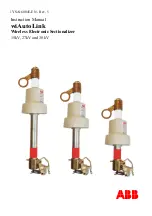
S&C Instruction Sheet 682-510 31
Dielectric Testing
Cable Testing and Fault Locating
Dc testing of installed cables is performed to determine
the condition of the cables and to locate faults. Industry
standards, such as IEEE 400, “IEEE Guide for Making
High-Direct-Voltage Tests on Power Cable Sys tems in the
Field,” describe such testing and should be referenced for
selection of the test procedures. Dc testing also includes
cable “thumping,” i.e., the sudden application of dc voltage
from a large capacitor for the pur poses of fault locating,
which causes tran sients and voltage doubling at the end
of the open cable. When the cables are attached to the
switchgear, the gear will also be subjected to the dc test
voltages.
On A and C phases, cable testing can be performed
using standard industry practices in accordance with the
warnings and maxi mum test voltages indicated in Table 2.
If testing is to be performed on a cable attached to phase
B of any load-interrupter switch or fault-interrupter way,
the voltage transformer (if provided optionally) must be
isolated from the test voltage. This can be done by opening
the load-interrupter switch way or fault-inter rupter way
connected to the cable being tested (or just open phase B
if it is a sin gle-pole fault-interrupter way).
Vista switchgear has been designed to allow dc testing
of the cables with the other ways of the gear energized.
The integral GROUNDING switch may be used to ground
the cable. After testing, the dc test equipment should be
used to discharge any stored charge on the cable before
regrounding with the GROUNDING switch. The dc test
voltages and dc cable thumping voltages should not exceed
the voltages given in Table 1 on page 30 and Table 2.
WARNING
The dc withstand capability of the switchgear may be
reduced because of aging, damage, gas leakage, or
electrical or mechanical wear . Therefore, the dc test
voltage must be selected so it does not exceed the
withstand limits of the switchgear .
Applica tion of dc
test voltages greater than the withstand capabil-
ity of the switchgear can result in a flashover,
injury, and equipment damage.
In addition, always verify that the SF
6
pressure
gauge is in the Green zone before proceeding with
any testing .
DANGER
Do not exceed the test voltages given in Table 1 on
page 30 and Table 2 . Exceeding the test voltages
can cause a flashover of the isolating gap or phase-
to-phase insulation of the switchgear .
This can lead
to a power-frequency fault in the gear or of the dc
test source and result in severe personal injury
or death.
Fault-Interrupter Testing
When performing dielectrical tests on Vista switchgear,
the vacuum fault interrupters will not be subject to
voltage across the open gap because the disconnect
switch will isolate the vacuum interrupter from the test
voltage. Because the vacuum interrupter will not be ener-
gized across the open gap, there is no expo sure to X-rays
normally associated with high-voltage testing of vacuum
devices. Routine testing of the vacuum fault interrupt ers
is not recommended. For those users who desire to test
the vacuum interrupters, contact the nearest S&C Sales
Office for specific instructions.
WARNING
When it is necessary to test the cables connected
to a unit of energized switchgear, proper isolation
of the power-frequency source from dc test source
must be maintained . Follow the recommendations by
the manufacturer of the dc test equipment or
fault-location equipment . The user’s operating and
safety procedures should be followed for grounding
the cable, connecting the dc test source, isolating the
dc test source (in case of flashover), ungrounding the
cable, applying the dc test source, discharging the
cable, and ungrounding the cable .
Table 2. Maximum Cable Test and Cable Thumping Voltages
Vista Switchgear Rating, kV
Dc Cable Test Voltage, kV
Dc Cable Thumping
Voltage, kV
①
50 Hertz
60 Hertz
Impulse (BIL)
12
15 .5
95
30
15
24
27
125
40
20
36
38
150
40
20
①
The dc cable thumping voltage is 50% of the dc cable test voltage
because of voltage doubling that will occur at the open end of the cable
that is assumed to be a unit of the Vista switchgear . If the open end of
the cable is grounded, the dc cable thumping voltage applied to the
cable and switchgear can be increased to the dc cable test voltage .
































